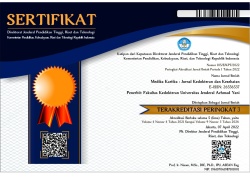INFERTILITAS PADA WANITA AKIBAT INFEKSI GONORE
Abstract
Gonore (GO) merupakan infeksi menular seksual (IMS) akibat Neisseria gonorrhoeae, bakteri gram negatif yang bersifat patogen obligat intraseluler penyebab infeksi permukaan mukosa organ reproduksi pria dan wanita, faring, rektum, dan konjungtiva. Infeksi GO ascending pada tuba falopii berdampak jangka panjang dan serius pada organ reproduksi wanita. Kerusakan organ reproduksi pada infeksi GO dan respon inflamasi dapat menyebabkan penyakit radang panggul, jaringan parut tuba falopi, risiko kehamilan ektopik, dan infertilitas tuba wanita. Tujuan penulisan tinjauan pustaka ini untuk memahami dampak infeksi N. gonorrhoeae terhadap infertilitas wanita sehingga dapat meningkatkan kesadaran untuk melakukan deteksi dini serta memberikan penanganan yang tepat dalam upaya pencegahan terjadinya infertilitas.
Kata Kunci : gonore, infertilitas, infeksi menular seksual, wanita
DOI : 10.35990/mk.v6n1.p91-102
References
2. Rowley JD. chlamydia, gonorrhoea, trichomoniasis and syphilis: global prevalence and incidence estimates 2016. bull world heal organ. 2019; 97 (1):548-562.doi:10.2471/BLT.18.228 486
3. Anyalechi TD. self-reported infertility and associated pelvic inflammatory disease among women of reproductive age national health and nutrition examination survey, united states, 2013–2016. ASHA. 2019; 46(7): 446–51.doi:10.1097/OLQ.0000000000 000996.
4. Apari P, Sousa JD. why sexually transmitted infections tend to cause infertility: an evolutionary hypothesis. plos pathog. 2014; 10(8): 1–3. doi:10.1371/journal.ppat.1004111
5. Kirkcaldy RD, Weston E, Segurado AC. epidemiology of gonorrhoea: a global perspective. sex heal. 2019; 161(1):401–11.doi:10.1071/SH190 61
6. Puspitosari D. gonorrhoea infection prevalence in human immunodeficiency virus positive patients based on polymerase chain reaction examination. int j integr heal sci.2014;2(1):1–8.doi: 10.15850/ijihs. v2n1.270
7. Mawardi P, rosita f, fitriani f. profile of sexually transmitted infection at dermatovenereology clinic dr. moewardi hospital surakarta central java. dalam: prasetya h, penyunting. proceding dari the 6th international conference on public health. 24 oktober 2019; surakarta, indonesia. h.360. doi:https://doi.org/10.26911/the6thicph.05.26
8. Vander BM. fertility and infertility: definition and epidemiology. clin biochem. 2018;62(march):2–10. doi: 10.1016/j.clinbiochem.2018.03.012.
9. Reekie JD. risk of ectopic pregnancy and tubal infertility following gonorrhea and chlamydia infections. clin infect dis. 2019; 69(9): 1621–3. doi: 10.1093/cid/ciz145.
10. Chhetri A, biswas s, gupta k. infection and infertility. dalam: mukherjee g, khatsgir g, basu s, penyunting. practical guide in infertility. edisi ke-1. india: the health sciences publisher; 2018. h. 107–20
11. Strowd LC, mcgregor s, pichardo r. gonorrhea, mycoplasma, and vaginosis. in: kang, s. d, editor. fitzpatrick’s dermatology. 9 ed. new york: mcgrawhills; 2019. hal. 3207–12.
12. Reddy BS, khandpur s, sethi su. gonococcal infections. dalam: nasim s, kumar b, gupta s, penyunting. sexually transmitted infections. edisi ke-1. new delhi: elsevier; 2012. h.473–94.
13. Daili SF, nilasari h. gonore. dalam: menaldi sl, penyunting. ilmu penyakit kulit dan kelamin. edisi ke-7. jakarta: balai penerbit fkui; 2016. h.443–9.
14. Danielle, G., tsevat, ba., harold, c., wiesenfeld, cm., peipert m. sexually transmitted diseases and infertility. Am J Obs Gynecol. 2017;1–9.doi:10.1016/j. ajog.2016.08.008.
15. Quilin S. neisseria gonorrhoeae host adaptation and pathogenesis. nat rev microbiol. 2018; 16(1): 226–39. doi: 10.1038/nrmicro.2017.169.
16. Mitchell PM. pelvic inflammatory disease current concepts in pathogenesis, diagnosis and treatment. infect dis clin n am. 2013; 27(1): 793–809.DOI:10.1016/j.idc.2013.08. 004
17. Benksim A, elkhoudri n, addi ra. difference between primary and secondary infertility in morocco: frequencies and associated factors. int j fertil steril. 2018; 12(2): 1-8. doi: 10.22074/ijfs.2018.5188.
18. Anwar SA. infertility: a review on causes, treatment and management. womens heal gynecol. 2016; 2(6): 2–5.https://scientonline.org/openaccess/infertility-a-review-on-causes-treatment-and-management.pdf. Diakses pada 2 Maret 2020
19. Papp JR, schachter j, gaydos ca. recommendations for the laboratory-based detection of chlamydia trachomatis and neisseria gonorrhoeae 2014. mmwr recomm Rep. 2014; 63(0): 1–19. https://www.ncbi.nlm.nih.gov/pm c/articles/PMC4047970/pdf/nihms-584 676.pdf. diakses pada 3 Maret 2020
20. Unemo M. gonorrhoea. dalam: ballard r, penyunting. laboratory diagnosis of sexually transmitted infections, including human immunodeficiency virus. switzerland: world health organization; 2013. h. 3–7. tersedia dalam : https://apps.who.int/iris/bitstre am/handle/10665/85343/9789241505840_eng.pdf. Diakses pada 1 Maret 2020
21. Division of Sexually Transmitted Disease Prevention, National Center for HIV/AIDS, Viral Hepatitis, STD, and TB Prevention C for DC and P. gonococcal infections. centers for disease control and prevention. 2015. tersedia dalam https://www.cdc.gov/ std/tg2015/gonorrhea.htm.diakses pada 1 Maret 2020
22. World Health Organization. who guideline for the treatment of neisseria gonorrhoeae. switzerland: world health organization; 2016. tersedia dalam : https://www.who.int/publications/i/item/9789241549691. Diakses pada 1 Maret 2020
23. Centers for Disease Control and Prevention. pelvic inflammatory disease. 2015. tersedia dalam https://www.cdc.gov/std/tg2015/pid.htm%0D. Diakses pada 20 Februari 2020
24. Dalal R. infection and infertility. intech open. 2016; 2(2): 1–19. doi: 10.5772/64168
25. Piszczek J. gonorrhea: treatment update for an increasingly resistant organism. can pharm j. 2015; 148(2): 82–9. DOI:10.1177/1715163515570111




























